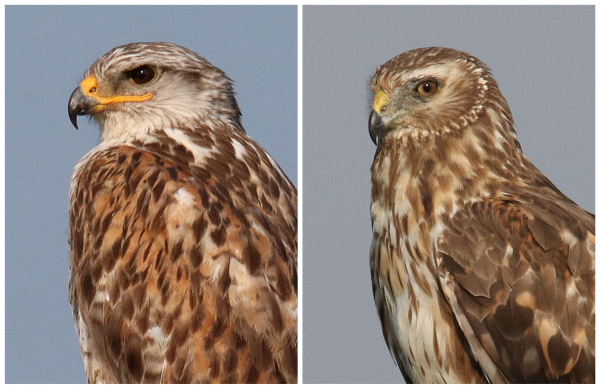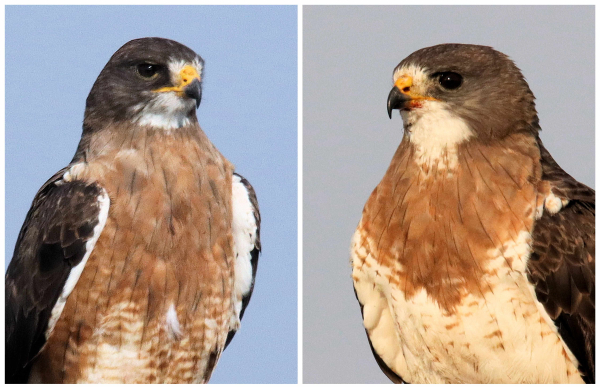With the promise that my Saturday afternoon drive should produce some exciting birding experiences, I had picked a favorite outback route anchored by the 2 Ferruginous Hawk nest sites I’ve been monitoring. Ferrugs are special prairie raptors, tied to the Missouri Coteau by its rich small mammal populations. But that prey base is not connected expressly to Ferruginous Hawks, but also to Swainson’s Hawks, Red-tailed Hawks, and Northern Harriers during summer, along with a variety of falcons, eagles, and other hawks during migrations and even winters. But my attention was focused on Saturday afternoon and the raptors I might find – the first migrants, dispersing raptor fledglings, adults still on territory.

It’s the time of year when things are changing, so I was excited, and already tuned in to the potential for raptor photographs as I left my office. Not disappointed, numbers of Red-tails and Swainson’s Hawks were active along the route I planned toward the south Ferruginous nest, but would there be any hawks on hand? A week before none of the 3 fledglings or the adults were to be seen during my quick nest check that extended for miles in each direction. This time, an adult Ferrug was perched in the midst of the hayfield south of the nest site, and another was perched in similar habitat about a half-mile north – but no fledglings again; perhaps they have dispersed.
The adult male provided a few photos from a distance, and when he took flight and began soaring in ever-higher circles I followed its movements through my camera lens, watching for when the sunlight illuminated it best. As I was taking what I expected to be my last photo as the hawk’s elevation evaded good photo range, the raptor defied my imagination by suddenly folding its wings and dropping straight downward, fast, in a gravity-fueled dive for more than 100 feet, pulling up when about 30 feet above ground – wooo, what a fine start to the afternoon!
As it turned out, I observed 38 raptors, including 37 hawks (21 Swainson’s Hawks, 11 Red-tailed Hawks, 3 Ferruginous Hawks, and 3 Northern Harriers) and 1 adult Bald Eagle. It was nice to see the first Swainson’s Hawk fledgling of the summer, followed by a brood of 3 beautiful Swainson’s fledglings still on territory near their nest with 2 adults protecting and feeding them as they are mastering flight and beginning to hunt for themselves. In fact, that family group inspired me to return the following morning with the hope of getting additional photos of the beautifully colored fledglings. But the afternoon had many photo opportunities, hawks in flight and perched, but it was challenging, with some birds more cooperative, some more trusting, many too distant, and some apparently not interested in participating in my raptor photo session.

From the beginning, it was evident that I would need to overlook the perches the raptors were using, many unsightly for the kinds of photos I prefer to share with readers, associates, piers, family, and friends. Therefore, with photos of impressive, stately, exceptional birds of prey perched on what I consider unsightly perches, I took full advantage to turn the best photos into portraits, perhaps a bit textbook looking, but a somewhat uniform presentation of the hawks I found Saturday afternoon and evening.
It was one of those special birding sessions, bird photography sessions, that I wished wouldn’t end, and I would have kept going if the sun didn’t set. I even took a series of sunset raptor portraits of a beautiful Red-tailed Hawk hunting just a quarter mile south of my office. This bird was very trusting, with fresh new plumage, signaling it was a fledgling. However, when it eventually took flight it showed a spread of red-orange tail feathers – it was clearly an adult. The impressive Red-tail was still on hand Sunday morning, as was an adult Swainson’s hawk a half-mile farther south, but neither offered a photo op, so I headed for the Swainson’s family I encountered 14 hours earlier.
My morning drive was short-stopped 8 miles away by the appearance of an adult Swainson’s Hawk perched on a hay bale along the roadside, and just beyond that bird were its 2 rufous-breasted fledglings. These hawks and a second adult occupied my camera for a half-hour or so, thankfully, and I encountered another Swainson’s family group – a fledgling and adult perched in an open treetop near the road – with more photo ops there. I also photographed a young Red-tailed Hawk closer to my intended Swainson’s Hawk destination; it was clearly a banner weekend to observe and photograph birds of prey.

One other hawk of note was a female Northern Harrier that was perched on a rusty metal fencepost along the roadway. Usually harriers don’t perch in the open like other hawks, but I figured luck was with me that afternoon and reversed my route to try what would be a very low percentage chance of getting a photo of the perched harrier. But this striking adult female turned out to be the 1 in 50 individual that permits a close enough approach to photograph it before it takes flight.
The hawk never looked in my direction, first looking away as though hunting, then to my left and right before taking flight. I was especially happy to get some photos of this impressive female, especially considering I only saw 3 harriers among the 38 raptors, and only 1 female. I have many nice photographs of Northern Harriers in flight – adult males, adult females, and first-year birds – but I have very few photos of a perched harrier; and then, usually standing on the ground rather than on an elevated perch.
Trials & Techniques
As noted above, my trials were photogenic birds of prey perched at unattractive locations. My answer was to crop out the “unsightly” perches, and to emphasize portraits of the regal hawks from the shoulders up. The only downfall to this plan was that some of the photos were taken at a distance that didn’t permit optimum enlarging. When you crop a photo, you are effectively enlarging the selected image inside the overall photo. In some cases it turns out that by trying to create a head and shoulders portrait, the resulting image was not as sharp as it should be to share with others or for publication. Another concern was that the enlarged portrait can have a somewhat grainy appearance, especially when the background is a uniform color.
Appreciating the limits of a given image and rejecting the results if they don’t meet your personal quality preferences are important factors to consider when cropping to a close portrait level. In fact, some of the resulting portraits don’t meet “my personal preferences,” but I’m including them here because they fulfill an important function by showing examples of a number of species of hawks in one place – all photos taken the same weekend not far from home – and to show how the sharpness and grain can be factors when cropping and enlarging photos.

One way to avoid these pitfalls is to try getting closer to a bird, without alarming it, so you don’t need to crop as much extraneous background. But usually we get as close as we think we can, or as close as possible under the geographic circumstances, with reference to not impacting the bird or its behavior – the birds always come first.
To help improve photos you intend to enlarge by cropping, be sure to is to focus directly on the bird, preferably on one eye. The sharper the image of the face, the better the image will be overall. I also try to keep a pleasing background when possible, sometimes by taking a step left or 2 steps right to try to eliminate a branch or wire from the image, for example. You can also try to blur the background out of focus by using a narrow aperture, say an f-5 when possible.
The ultimate interest when photographing any birds is to time your photo sessions during periods of sunlight when the light is coming at an angle from behind you. Always try to keep the sun behind you, with your subject in front of you. An easy way to keep track of that in the heated moments of photographing is to let your shadow be your guide, by checking to see that your shadow points at the bird, thereby reinforcing that the sun is behind you.
Then too, you need to dedicate some time to your bird photography interests. It’s good to have some preconceived ideas of what to watch for during a photo session, but it’s also good to go with the flow while birding with your camera. For example, while I imagined birds of prey might be a major factor in my birding drive Saturday afternoon, I didn’t come up with the idea of using portraits to be the theme of this article ahead of time. By reviewing the photos, it was clear that portraits might be the best to way to present these photos of individual hawks and different species using a single theme. As always, enjoy the process, your surroundings, and the fresh air in the great outdoors, camera in hand.
Article and Photographs by Paul Konrad
Share your bird photos and birding experiences at editorstbw2@gmail.com